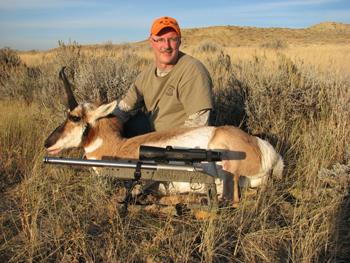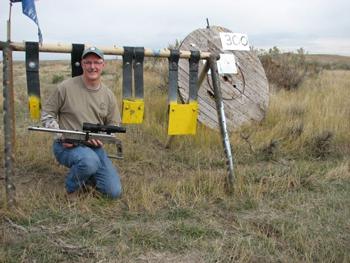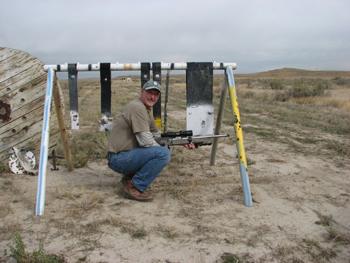Antelope Hunting-Burris Eliminator Laserscope Review
By Ernie Bishop
This past year, while preparing for an antelope and prairie dog hunt with long time hunting buddy, Steve Hugel from Colorado, I installed a 4-12x Burris Eliminator optic on my BAT rear-grip specialty handgun, chambered in 7mm WSM. The fitting and chambering of this 1:9 twist Bartlein barrel and brake were done by Eric Wallace of Nawakwa Accuracy. I am using H-1000 powder, Winchester brass, Federal 210 Match primers, and 180-grain Bergers for a muzzle velocity of 2570 fps. Chuck from Mac's Gunworks had originally chambered this rig as a 6.5 Leopard (WSM), and put a Cerakote camouflage finish on the McRee stock and fitted it to the action at that time. I had wanted to try out this scope in the field, and this was the perfect opportunity.

The day before Steve came out I installed the Eliminator on the specialty handgun. Once that was finished I quickly breezed through the Burris instruction manual, and pushed the button on the left side of the scope to program it, only to be rewarded with no power whatsoever. First, I checked the battery to make sure it was in right. Then I went and got two spare batteries from my pack, and they didn't work. Now, what else was a guy to do, but grab a rubber mallet and smack it a few times…Just kidding! Sure enough, as you may have guessed, all the batteries were dead. I grabbed my Swarovski LRF then, took the battery out, put it in the Eliminator, and presto, it worked just like the instructions said it should. So much for the ingenuity of the common man. A trip was made to Wal-Mart later that afternoon for fresh batteries.

Steve got in late (like 3AM late) and needed some extra beauty sleep, so we got a late start after a good breakfast at Perkins. We headed out to Mac's Gunworks to confirm drops out to 600 yards, and maybe even as far out as 700. After bore-sighting, I got it zeroed at 100. I then zeroed the turrets and prepared to shoot at 500 yards. I lasered the target and inside the scope it displayed the range and then a red aiming point lit up below the crosshair. Could it really be that easy, I wondered?
I didn't hold-off for wind on the first shot as I was interested mainly in vertical drop, not wind drift at the moment. A second or so after the shot, the oh-so-sweet sound of a bullet slapping steel confirmed the scope's capability. I did make one click correction up and left, as we again checked the 100-yard target. I held off for wind on the next shot then, and made a nice hit at 500 yards. Now I decided to go back to steel at the 200-, 300-, and 400-yard steel targets. At each range the Eliminator made the exact correction called for. I skipped 500 yards then, moved right to 600 and was rewarded with a center hit. The Eliminator lasered the 700-yard target correctly, but the scopes internal capabilities had then been exceeded. I think if I had been using my 6.5 Leopard, this cartridge's load is so flat to 700 yards (93 inches of drop versus 128), that it would have allowed the scope to provide a shooting solution to that range. Needless to say, I had great expectations and it was now time to go antelope hunting.

This hunt was not about trophy size, but determining how the Eliminator would perform in the field. After a period of time we found a buck, and made a stalk to within 316 yards. Everything functioned as it should, and one tag was filled. By the time we got him quartered, it was late and we headed home feeling both pleased and tired. We hoped we would be able to get on another buck early in the morning, so we could do some prairie dog shooting with 22LR specialty handguns (story for another time).
Good fortune was with us that next morning as we were able to quickly get on a couple of bucks. We thought we would be making a stalk in one direction, but ended up going in another. Such is antelope hunting at times. The bucks were on the move, so I continued to range the bigger animal with the Eliminator. Invariably, every time I ranged him, the optic would give me the distance and the red LED would light up on the vertical crosshair showing me where to aim. If the optic cannot get a good read, it will light up all the 200-, 300-, 400-, and 500-yard aiming points at once. When this happens, it essentially converts it into a multi-stadia ballistic reticle, which can be very useful if you know the distance because of previous ranging.
The buck finally stopped broadside at 490 yards. I ranged him again, and was getting ready to shoot, when I noticed the other buck heading his way. For whatever reason, I was in a hurry to pull the trigger before buck #2 lined up for a very undesirable "double." Post mortem, I discovered I'd shot about 3 inches low, and wondered if this happened because I rushed the shot when I saw the other buck coming. I should have just waited for him to clear, but for whatever reason that didn't happen. I wish I could say that I never make a mistake when shooting in the field. It seems if I am paying attention, I can always find an area or two where I can improve. As you will see in the picture below, Steve and I had yet another buck to dress out.
By Ernie Bishop
This past year, while preparing for an antelope and prairie dog hunt with long time hunting buddy, Steve Hugel from Colorado, I installed a 4-12x Burris Eliminator optic on my BAT rear-grip specialty handgun, chambered in 7mm WSM. The fitting and chambering of this 1:9 twist Bartlein barrel and brake were done by Eric Wallace of Nawakwa Accuracy. I am using H-1000 powder, Winchester brass, Federal 210 Match primers, and 180-grain Bergers for a muzzle velocity of 2570 fps. Chuck from Mac's Gunworks had originally chambered this rig as a 6.5 Leopard (WSM), and put a Cerakote camouflage finish on the McRee stock and fitted it to the action at that time. I had wanted to try out this scope in the field, and this was the perfect opportunity.

The day before Steve came out I installed the Eliminator on the specialty handgun. Once that was finished I quickly breezed through the Burris instruction manual, and pushed the button on the left side of the scope to program it, only to be rewarded with no power whatsoever. First, I checked the battery to make sure it was in right. Then I went and got two spare batteries from my pack, and they didn't work. Now, what else was a guy to do, but grab a rubber mallet and smack it a few times…Just kidding! Sure enough, as you may have guessed, all the batteries were dead. I grabbed my Swarovski LRF then, took the battery out, put it in the Eliminator, and presto, it worked just like the instructions said it should. So much for the ingenuity of the common man. A trip was made to Wal-Mart later that afternoon for fresh batteries.
The LRH Store offers the entire Burris line including the Eliminator Series of range finding scopes with FREE SHIPPING. The newest model, Burris Eliminator III 4x-16x-50mm, functions out to 1,000 yards. Read Roger Seale's review HERE.
I set it to read in yards (as opposed to the other option of meters) for a 100-yard zero. Now I needed to know my drop in inches at 500 yards from a 100-yard zero. I opened up Exbal Ballistics Calculator, and checked the numbers, and it told me fifty-five inches. I have a chronograph and already knew my load's specs., but with the Eliminator you don't even need to know your muzzle velocity or your bullet's ballistic coefficient for it to be accurate. A solid 100 yard zero and a measured drop from your aiming point in inches at 500 yards is all that's needed. Sounds too good to be true, but it works.
Steve got in late (like 3AM late) and needed some extra beauty sleep, so we got a late start after a good breakfast at Perkins. We headed out to Mac's Gunworks to confirm drops out to 600 yards, and maybe even as far out as 700. After bore-sighting, I got it zeroed at 100. I then zeroed the turrets and prepared to shoot at 500 yards. I lasered the target and inside the scope it displayed the range and then a red aiming point lit up below the crosshair. Could it really be that easy, I wondered?
I didn't hold-off for wind on the first shot as I was interested mainly in vertical drop, not wind drift at the moment. A second or so after the shot, the oh-so-sweet sound of a bullet slapping steel confirmed the scope's capability. I did make one click correction up and left, as we again checked the 100-yard target. I held off for wind on the next shot then, and made a nice hit at 500 yards. Now I decided to go back to steel at the 200-, 300-, and 400-yard steel targets. At each range the Eliminator made the exact correction called for. I skipped 500 yards then, moved right to 600 and was rewarded with a center hit. The Eliminator lasered the 700-yard target correctly, but the scopes internal capabilities had then been exceeded. I think if I had been using my 6.5 Leopard, this cartridge's load is so flat to 700 yards (93 inches of drop versus 128), that it would have allowed the scope to provide a shooting solution to that range. Needless to say, I had great expectations and it was now time to go antelope hunting.

This hunt was not about trophy size, but determining how the Eliminator would perform in the field. After a period of time we found a buck, and made a stalk to within 316 yards. Everything functioned as it should, and one tag was filled. By the time we got him quartered, it was late and we headed home feeling both pleased and tired. We hoped we would be able to get on another buck early in the morning, so we could do some prairie dog shooting with 22LR specialty handguns (story for another time).
Good fortune was with us that next morning as we were able to quickly get on a couple of bucks. We thought we would be making a stalk in one direction, but ended up going in another. Such is antelope hunting at times. The bucks were on the move, so I continued to range the bigger animal with the Eliminator. Invariably, every time I ranged him, the optic would give me the distance and the red LED would light up on the vertical crosshair showing me where to aim. If the optic cannot get a good read, it will light up all the 200-, 300-, 400-, and 500-yard aiming points at once. When this happens, it essentially converts it into a multi-stadia ballistic reticle, which can be very useful if you know the distance because of previous ranging.
The buck finally stopped broadside at 490 yards. I ranged him again, and was getting ready to shoot, when I noticed the other buck heading his way. For whatever reason, I was in a hurry to pull the trigger before buck #2 lined up for a very undesirable "double." Post mortem, I discovered I'd shot about 3 inches low, and wondered if this happened because I rushed the shot when I saw the other buck coming. I should have just waited for him to clear, but for whatever reason that didn't happen. I wish I could say that I never make a mistake when shooting in the field. It seems if I am paying attention, I can always find an area or two where I can improve. As you will see in the picture below, Steve and I had yet another buck to dress out.

